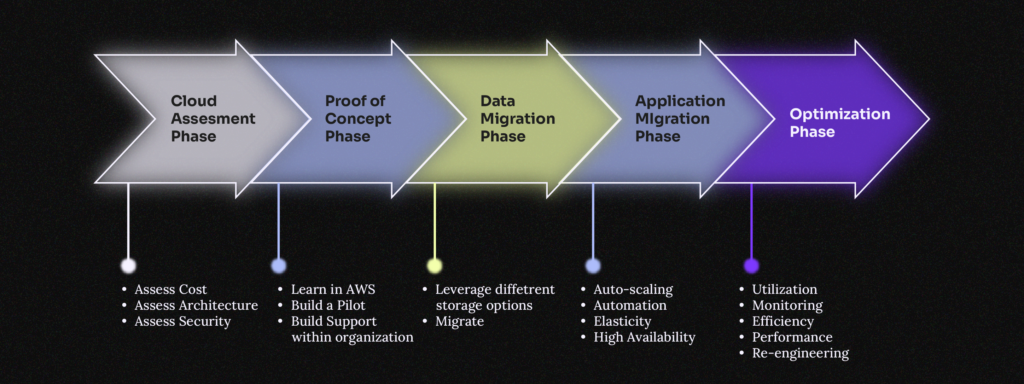Cloud migration isn't just a trend; it's a fundamental shift in how companies manage and deploy their IT resources. According to Gartner, the market for cloud services expanded by over 20% between 2022 and 2023 to nearly $600 billion.
Shifting to the cloud is a strategic leap that unburdens your tech team and elevates your business capabilities. Especially for smaller enterprises, it's like a secret weapon, empowering you with top-tier cybersecurity, seamless disaster recovery, effortless data portability, and access to cutting-edge apps – all without breaking the bank.
Want to unpack savvy strategies for a seamless cloud migration? We'll explore how cloud computing can be a game changer for your business. Consider this guide your insider's playbook to maximize impact.
What is Cloud Migration?
Cloud migration entails moving your IT operations and applications off-premises and onto remote servers. This transition not only streamlines operations but also offers unparalleled flexibility and accessibility. It's an essential strategy for businesses seeking to enhance efficiency, scalability, and innovation.
Public, private, and hybrid cloud migrations are most common. Each offers unique advantages tailored to different business needs. Public cloud migrations involve moving data to tech-heavy hitters like Amazon (AWS) and Microsoft Azure. These two companies control more than half of the market, with Google Cloud, Alibaba, and Oracle trailing behind.
Private cloud migrations, on the other hand, focus on custom cloud environments for enhanced security and control but are more costly. Hybrid cloud strategies blend both, providing a balanced approach.
Effective cloud migration strategies involve careful planning. Choosing the right type of cloud environment ensures seamless integration and minimal disruption. As a result, cloud migration is not just about technology; it's about strategically transforming business operations to leverage the power of the cloud.
Cloud Migration Strategies
There's no one-size-fits-all approach to the cloud migration process. In the current meta, there are five types of cloud migration, and you're not confined to a single approach. Flexibility is key – mix and match elements from different models to suit your needs.
For example, you might use a "lift and shift" approach for certain applications, moving them to the cloud as-is, especially when dealing with sensitive customer data. Simultaneously, you could phase out traditional antivirus solutions in favor of more cost-effective, cloud-native alternatives. This tailored approach ensures that your migration strategy is as dynamic and efficient as your business demands.
Understanding these types helps in choosing the most suitable strategy for your organization's needs:
Rehosting (Lift and Shift)
Rehosting is by far the most straightforward cloud migration strategy. As you might have guessed from the term lift and shift, this doesn't involve major restructuring. Existing applications are moved to the cloud without any modifications, lifting your software and data from your current environment and shifting it to a cloud-based infrastructure. This method is fast and cost-effective, making it a popular choice for businesses looking to migrate quickly. No changes are made to how your applications work, though users might notice lower latency from the expanded bandwidth and better internal speeds after your application migration.
In 2017, the industrial giant General Electric rehosted more than 9,000 workloads to AWS. In doing so, the company dropped its data center count from 34 to just four, saving tons of overhead and freeing up loads of IT staff for other mission-critical tasks.
Replatforming
When you replatform, you rehost with minor modifications and upgrades to legacy applications. The core architecture of the application remains the same, but it's tweaked to better align with the cloud environment.
This approach is a middle ground for organizations looking to gain some cloud benefits without the cost or complexity of a full refactor. It's about optimizing the application to run more effectively in the cloud, such as adjusting how it interacts with the database or leveraging cloud storage options.
The goal of replatforming is to improve efficiency and performance in the cloud without a complete overhaul. It's a strategic choice for businesses that want a less disruptive transition. This can be a good option if you're new to cloud-based migration projects and want more than a simple lift and shift but aren't ready for a full refactor or rebuild.
Refactoring (Repackaging)
Refactoring is the term for data migration with significant restructuring, which you can call re-architecting if you're losing at Scrabble, and it's a more labor-intensive cloud migration plan than the previous two.
In this approach, applications are partially modified to fit into a cloud environment. You'd do this when there's some cloud-native feature you'd like to try out, like serverless computing, or when you want to be better prepared for growth with some serious scalability built into your applications.
When online retailer eBay refactored with Google Cloud in 2018, the company took advantage of the move to add a bunch of new AI and image recognition applications. As a result of the new processes, eBay saw what would have been a 40-day development process chopped to just four, thanks to Google's top engineers and years of experience.
Repurchasing (Drop and Shop)
Repurchasing involves dropping the traditional licensing arrangements you have for your existing applications and buying into cloud-native options to meet your business needs.
This method is chosen when the existing application is outdated or incompatible with modern cloud environments. Repurchasing offers the opportunity to start fresh, taking full advantage of the latest cloud capabilities, but it requires substantial investment in development. This approach is particularly relevant in the following aspects:
- Switching to SaaS products – Instead of hosting and managing software applications internally, companies opt for third-party services. This shift often leads to the adoption of more modern, scalable, and feature-rich applications.
- Cost-effectiveness and efficiency – Repurchasing might seem like a significant upfront change, but it can be more cost-effective in the long run. It eliminates the need for internal maintenance and updates since the SaaS provider handles these responsibilities. This can lead to reduced operational costs and improved efficiency.
- Ease of Integration and Scalability – Cloud-native SaaS solutions are designed for easy integration with other cloud services and systems. They also offer scalability, allowing businesses to adjust their usage based on current needs without worrying about physical infrastructure limitations.
An example of repurchasing would be moving from a self-hosted email server to a cloud-based email service like Microsoft 365 or Google Workspace, or switching from an on-premise CRM system to a cloud-based solution like Salesforce.
By repurchasing and moving to SaaS products, companies can focus more on their core business functions rather than on the complexities of managing IT infrastructure and software.
Retiring and Retraining
Retiring is just what it sounds like — putting old applications to bed when they've outlived their usefulness and retaining what you want to keep using. When the business value of a product is less than the cloud costs of migration, it can be let go. You'll keep the good stuff, though, and shifting to a new cloud platform could be the perfect time to make the modernization decisions you've avoided for years.
When finance leader Capital One made the surprising decision to move into a public cloud in 2018, it took the opportunity to kick off a major retiring and retaining project. In a few years, the company ditched its older risk-management processes, built out new machine-learning applications using Ansible as an automation tool, and invested heavily in a cloud-based AI model that was partly off the shelf and partly custom-built.
Key Benefits of Cloud Migration
Cost Efficiency and Better Resource Management
You can save a ton of money by switching to cloud solutions. That's because moving onto cloud infrastructure saves you on the upfront cost of capital expenditure and shifts expenses toward the operational side, which is more on-demand or pay-as-you-go. Not only are you getting the economies of scale smaller businesses might not have access to, but you're also getting real-time analysis and feedback on how much you're using certain products and whether they're worth keeping.
Scalability and Improved Flexibility
Growing your business is all about scaling. As workloads increase, so do latency and lag times unless you work with an almost infinitely expandable cloud provider. If you're still working from your own data center, even a tiny expansion might come with a considerable outlay in new infrastructure. That money is sunk if the expansion is only temporary, like if you have a sudden surge of work with a new contract, followed by a return to normal. With cloud infrastructure, you can order an expansion for as long as you need it, then shrink back to normal at minimal cost.
Enhanced Security and Compliance
There should be no compromise with data security and compliance requirements. Even a small slip in either area, such as cloud data governance, could cost your business dearly. A cloud-based digital transformation puts you in touch with security tools you were priced out of before, giving you a competitive edge over rivals and saving you tons of trouble in fines, lost business, and avoidable downtime.
Improved Collaboration and Innovation
The cloud's universal accessibility is one of its standout features. In today's global workforce, teams are just as likely to be spread across continents as they are across office spaces. There's no substitute for having the ability to unite everyone in a shared public cloud environment.
You can strategically deploy your designers on one aspect of a project while your marketing team tackles another, and developers bridge the gap in the middle. The beauty lies in the near-instantaneous synchronization of changes across teams, ensuring seamless collaboration and efficiency.
Types Of Cloud Migration
Public Cloud
The public cloud is a cost-effective option for many small and middle-sized businesses. This is a third party that hosts data and provides data integration for more than one enterprise. So you might rent space on a server that hosts other clients, which is basically what you do when you pick off-the-shelf services like Google Cloud and Microsoft Azure.
Private Cloud
Private clouds are custom solutions that only serve one customer, you, and usually implement stricter security and access control. It's harder to hack a private cloud, and they are much more customizable for the needs of your enterprise, though this can be a pricier option.
Hybrid Cloud
Hybrid clouds give you the best of both worlds. You'll have some applications and relatively low-risk data transfer to affordable public environments, while your most sensitive stuff can be kept safe on what amounts to a private cloud provider. You can shift between them to get what you need in whatever feels like the most appropriate way.
Multi-Cloud Strategy
If your organization has the capacity, adopting a multi-cloud strategy can significantly enhance your flexibility. Utilizing services from giants like Google, AWS, and Microsoft simultaneously allows you to leverage the best of each platform. This approach prevents over-reliance on a single vendor and adds a layer of diversity to your storage and services, bolstering your overall resilience.
The Cloud Migration Process

Assessment and Planning
Assessment is a critical first step for any major transition, including cloud migration. This is where you pull your teams together and define the needs of your business, take stock of what you're using now, and prepare a migration plan that works for all the stakeholders. In this phase, you should:
- Define Business Objectives: Clearly outline what you want to achieve with cloud migration.
- Assess Your Current Infrastructure: Evaluate your IT setup to determine what can be moved to the cloud.
- Select Workloads for Migration: Identify which applications, data, and workloads will be migrated.
- Choose the Right Cloud Environment: Decide whether a public, private, or hybrid solution best suits your needs.
- Perform a Cost-Benefit Analysis: Assess the financial implications and potential savings of migrating to the cloud.
Choosing the Right Cloud Provider
Identifying your requirements is the first step; the next is to find a vendor that meets them. Evaluate each potential provider based on their pricing, technical prowess, and the level of tech support they offer. Don't forget to peruse their range of proprietary applications – sometimes, a unique offering can make a vendor particularly appealing.
Migration Tools and Services
Whichever provider you choose will come equipped with specialized migration tools to ensure a smooth transition. For straightforward migrations, they might even integrate a third-party toolset to expedite the process. Key considerations for this phase include:
Designing the Migration Plan
- Architecture Design: Plan the architecture of the cloud environment, ensuring it supports your applications and workloads.
- Migration Strategy: Choose a migration strategy, such as rehosting (lift-and-shift), refactoring, or rebuilding.
- Risk Management: Identify potential risks and prepare mitigation strategies.
- Compliance and Security: Ensure the cloud environment complies with relevant regulations and security standards.
Preparing for Migration
- Technical Readiness: Prepare your applications and data for the migration process.
- Skill Assessment: Ensure your team has the necessary skills or provide training.
- Communication Plan: Develop a plan to communicate the migration process to stakeholders.
Data and Application Migration
- Data Transfer: Move your data to the cloud environment using a secure method.
- Application Migration: Migrate your applications, often starting with the least complex ones.
- Testing: Rigorously test to ensure that applications and data function correctly in the new environment.
Execution and Optimization
Sooner or later, you'll need to make the move, transferring your apps and data to the cloud. Stick to your plan as closely as possible during this transition, holding off on any changes until you're fully established. There's always room for streamlining and optimization later on.
Post-Migration Optimization
- Performance Monitoring: Consider performance monitoring tools to monitor the performance of applications and workloads.
- Cost Optimization: Review and manage cloud spending and resources.
- Security Monitoring: Implement ongoing security monitoring and compliance checks.
Transition and Change Management
- Training: Train end-users and IT staff on the new cloud systems and processes.
- Shift Operational Practices: Update operational practices to align with cloud-based workflows.
- Continuous Improvement: Apply lessons learned to optimize processes and make continuous improvements.
Review and Compliance Check
- Audit: Conduct post-migration audits to ensure everything is running as expected.
- Compliance Verification: Verify that the migration has maintained all necessary compliance standards.
Maintenance and Evolution
- Regular Updates: Keep the cloud environment up to date with the latest features and security patches.
- Scalability: Scale the cloud resources up or down based on business needs.
- Future-proofing: Stay informed about new cloud technologies and trends to ensure the infrastructure remains current.
Overcoming Common Migration Challenges
Managing Downtime and Data Loss
Downtime and data loss can seriously disrupt cloud services. It's crucial to have a solid backup strategy in place. Always be prepared with a disaster recovery plan, ready to quickly restore your data if needed.
Skill Gaps and Training Needs
Moving to the cloud might mean investing in a training cycle to get everyone up to speed. The skills needed to move onto the cloud might differ slightly from what your IT department is used to. Schedule in-house retraining or consider outsourcing temporarily to close the gap.
Budgeting and Cost Management
Keep an eye on your budget during the transition. Cost overruns are unfortunately common during significant transitions like this, so it's probably a good idea to budget an extra 10% and always watch out for unforeseen complications or unexpected delays that can run up the cost.
Future Trends and Considerations in Cloud Management
The Role of AI and Machine Learning
Artificial intelligence is one of the most exciting new trends in hybrid cloud management. The expanded space and advanced applications you can get from a dedicated provider like Google Cloud are a low-risk way to try out machine learning for all sorts of applications.
Edge Computing and Cloud Migration
Depending on how your cloud infrastructure is organized, you might see much lower latency and faster processing with edge computing. This is a developing area of IT applications, so the potential for growth in real-time analysis and rapid development is promising for industries such as finance and communications.
Sustainability and Cloud Computing
Energy consumption is a significant expense for data centers, driving continuous efforts toward greater efficiency. Cloud vendors consistently strive to cut energy costs by optimizing server usage and enhancing cooling, fire suppression, and backup systems. These improvements often surpass the energy efficiency of on-premises servers across various enterprises.
Navigating the Evolving Tech Landscape
Nothing changes as fast as tech, and cloud environments are at the cutting edge of where that progress is happening. Your vendor is likely making every effort to stay ahead, offering your IT staff the advantage of ongoing advanced education without the drawbacks. What are your thoughts about cloud migration? Have you done it?
Subscribe to our newsletter for more on how cloud is reshaping the CTO role and advice on keeping pace with these changes.




